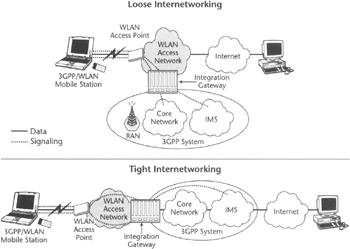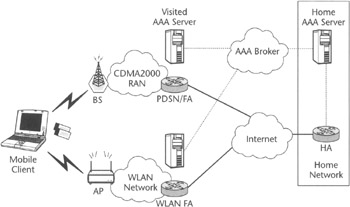WLAN/Cellular Convergence and MVPN
WLAN/Cellular Convergence and MVPN
In this section we consider the main mechanisms used to create converged MVPNs integrating wireless packet data technologies and systems such as Wireless LAN, GPRS, UMTS, and CDMA2000. Convergence of Wireless LAN hot spots with the cellular systems is considered here for a few reasons. First, it well exemplifies the problems and benefits associated with integration of different wireless networks in general, especially with regard to private networking over the resulting combined system. Second, it has a strong business case, further substantiated by the growing interest by customers, wireless carriers, and such new entrants in the world of mobile data services as local coffee shops, small businesses, hotels, airports, and railway stations. Finally, since different cellular systems support different compulsory MVPN mechanisms, it is easier to examine their properties and then apply the observation to the real-world design of the converged WLAN/single cellular system combination.
WLAN and Cellular Integration
At first look, the integration of WLAN and a typical cellular system seems unlikely. After all, WLAN, as we discussed in Chapter 3, is not a standardized system; it doesn't include subscriber data handling, location management, or mobility management, nor does it include built-in support for macro-mobility, fast handover, roaming, user authentication, and other attributes traditionally associated with a telecommunications system such as GSM. On the other hand, from both residential user and business application perspective the integration of WLAN and cellular systems makes sense. If properly integrated, WLAN can complement a typical 2G or 3G cellular system in many ways. WLAN throughput rates are far superior to those of even the latest wireless packet data systems such as UMTS. In addition, WLAN equipment is significantly less expensive and easier to install and support. While satisfying bandwidth-hungry road warriors, WLAN can at the same time offload the cellular infrastructure by serving subscribers in highly congested areas. WLAN combined with cellular systems can serve as a foundation for new revenue-generating data services such as high-speed MVPN access and other wireless data services requiring high throughput bearer.
These factors recently spurred a new breed of unlicensed wireless LAN operators known as Wireless Internet service providers, who install WLANs in strategic locations, where untethered high-speed data access is likely to be required. These so-called hot-spot locations, or WLAN hot spots, are fast gaining popularity with mobile data users and can be formed, upon mergers and acquisitions or federations of Wireless ISPs, into a network of locations capable of covering a wide area, especially when combined with a well-developed packet-data-based cellular system.
WLAN Integration Methods
WLAN/cellular integration is a relatively recent phenomenon, but there are already a number of mechanisms available that would allow for more or less seamless integration between the two. 3GPP SA1 has recently put a requirement for the interworking of WLAN with UMTS networks and to generate the standards that would govern it. As a consequence, 3GPP SA2 is currently working on defining the architecture and system aspects of WLAN and cellular systems integration. Another group, ETSI BRAN (for Broadband Radio Access Networks), was tasked with specifying mechanisms to define HiperLAN/2. Their resulting interim work can be seen in [ETSI BRAN TR101.957]. This document also attempts to classify WLAN/GPRS integration methods by defining two integration options: loose and tight (see Figure 9.4).
 Figure 9.4: Tight and loose cellular/WLAN integration options.
Figure 9.4: Tight and loose cellular/WLAN integration options.
| Note |
HiperLAN/2 is a system developed by the ETSI in 5-GHz band. It is almost identical to 802.11a at the physical layer, where it uses orthogonal frequency-division multiplexing (OFDM) and has the same data rates. |
Loose integration refers to a scenario where the WLAN traffic does not traverse the GPRS core and instead is directly routed to the Internet, so the only function shared by the two systems is authentication and accounting. Tight integration refers to a scenario when the WLAN traffic is handled by the elements in the GPRS core network or UMTS PS domain, such as GGSN, SGSN, and Charging Gateway Function. This classification is only applicable in the GPRS and UMTS systems framework, so instead we will analyze the WLAN/cellular integration methods based in part on the authentication mechanisms, paying special attention to IMSI- and NAI-based authentication with Mobile IP and support for MVPN and other services targeting the end-user.
Integration may allow for the same wireless data services across the different access technologies, as well as delivery of the same Mobile VPN services (in tight integration scenarios by using the same APN on the GGSNs used by the subscriber in the cellular network; or in loose integration scenarios, by using Mobile IP-based network access or voluntary tunneling-based solutions).
IMSI-Based Authentication for WLAN Integration
The IMSI-based mechanism assumes that the WLAN user device can be authenticated by the common cellular systems infrastructure the same way any cellular device is authenticated. For example, in GPRS the MS is authenticated via a built-in Subscriber Identity Module chipcard, so the first requirement for WLAN/GPRS IMSI-based authentication is the support of a SIM reader in the WLAN mobile terminal equipment. A good example is the WLAN PCMCIA card with a built-in SIM reader manufactured by Nokia, which introduced a combined SIM-based GPRS/WLAN device that addressed many user-side integration and compatibility issues. Today, over the radio link, this requires the use of a proprietary mechanism. For this reason, IEEE or the IETF's PANA Working Group are developing an approach to achieve this same functionality in standard fashion.
Network support for this scenario requires transporting standard cellular system authentication material from the WLAN access gateway to an interim gateway where the subscriber authentication material is downloaded from the HLR. This can be addressed by the introduction of a new network element that would integrate the WLAN and GPRS infrastructures and bridge the AAA protocol used by WLAN, such as RADIUS, with the MAP or TIA [IS41] signaling and AAA protocols used in cellular networks. For simplicity we will refer to such a device as an integration gateway. This gateway, depicted in Figure 9.4, may include other functionalities depending on the degree of WLAN integration with the cellular infrastructure.
In a tightly coupled integration scenario, the integration gateway can act in 3GPP systems as an SGSN from the cellular system point of view, interfacing to the CGF and GGSN and to the SGSN serving cellular radio access network. The compulsory MVPN access in this case will be supported by the GPRS infrastructure in a manner similar to that used for GPRS terminal users (see Chapter 6). In an alternative architectural approach—that is, loose integration—the integration gateway can be implemented as standalone equipment. In this case, only the WLAN AAA protocol and MAP or TIA [IS41] signaling and AAA protocols used in cellular networks are inter-worked, and traffic is directly delivered to the Internet. This approach is preferable and is fast gaining both vendor support and market acceptance.
The main function of the integration gateway in combined WLAN/GPRS systems is to convert the WLAN RADIUS-based accounting data into a GPRS billing format (typically in the form of G-CDRs files complying with 3GPP requirements [TS32.015]) and interworking RADIUS authentication with MAP-based access to the information stored in the HLR. The GPRS billing system may be upgraded to be able to identify the source of the CDRs in order to accurately bill the customer for WLAN versus GPRS usage.
IMSI-based authentication is not directly applicable in the CDMA2000 environment, since CDMA2000 authentication is not based on a SIM card or its equivalent. [2] Currently, the CDMA2000 authentication and accounting done by the PDSN and the HA (in the case of Mobile IP) is based on RADIUS. Because RADIUS authentication is also used in WLAN, the task of WLAN integration is relatively straightforward. The only requirement in this case would be to convert the WLAN accounting parameters to the form specified for CDMA2000 systems by TIA [IS835]. In CDMA2000 these consist of radio-specific parameters collected by the RAN and core-network-specific parameters collected by the PDSN. The PDSN then forms a Usage Data Record (UDR) consisting of both parameters, which is forwarded to a local AAA Server and possibly communicated over the AAA broker infrastructure (as discussed in Chapter 7).
NAI-Based Authentication and Mobile IP
Recall from the previous chapters that CDMA2000 core data networking is based on Simple IP and Mobile IP access methods, both of which rely on IETF-developed standards and GPRS and UMTS systems also allow for a Mobile IP-based private network access option. Also recall that Mobile IP can be supported over virtually any access network technology with no changes to the infrastructure and the protocol itself. These factors have led many in the industry to combine this technology with the equally ubiquitous NAI-based authentication, thereby introducing another WLAN/ cellular integration method. In contrast to the IMSI-based approach, this method more easily integrates with existing ISP and corporate AAA environments—although it requires the cellular operator in GPRS/UMTS systems to operate a RADIUS-based AAA server compatible with the WLAN AAA protocol.
There are two possible deployment scenarios for NAI-based authentication systems:
-
The MS is not allowed to hand off to the cellular system, and vice versa, without losing the session continuity. Therefore, the integration is only at the AAA level, and user mobility is expected to be limited if it exists at all. However, this model does not appear to be suffering much from mobility limitations, since in most of the cases, WLAN users are using laptops in hot spots and are therefore fairly static.
-
The intersystem handoff is enabled by Mobile IP support in the cellular infrastructure and in the WLAN infrastructure. Mobile IP-based WLAN/cellular infrastructure would require the Mobile IP FA to be supported by the WLAN access point or at intermediate gateways serving a group of APs (see Figure 9.5).

Figure 9.5: Mobile IP-based WLAN/cellular integration.
In the case of the CDMA2000, when Mobile IP access method is used, Mobile IP is of course natively supported. Users equipped with laptops that support WLAN and CDMA2000 access—for example, via two PCMCIA cards—can roam almost seamlessly between two different types of wireless access technologies, while preserving the user's IP address and end-to-end communications including voluntary tunneling or TLS session [RFC2246] to a private network. NAI-based authentication has the advantage of being supported by many standard types of WLAN equipment and standard IP-based protocols and hence by client software. Standard RADIUS proxy procedures, broker infrastructures, and IP authentication parameters are used for roaming and authentication.
In the case of UMTS and GPRS, a cellular operator offering Mobile IP-based WLAN integration is required to deploy a GGSN integrating Mobile IP FA functionality. This requires configuring the terminal to request the Mobile IP-capable APNs supported by these GGSNs, and to store subscription information in the HLR that allows the user to access these APNs.
| Note |
Using Mobile IP bypasses the need of a standardized protocol for carrying authentication for network access (as standardized by the IETF PANA WG), since this functionality is provided by Mobile IP itself. This may be yet another advantage of deploying a Mobile IP-based solution in the short term. |
[2]This situation, however, may soon change with SIM-based authentication in CDMA2000 systems being developed by 3GPP2.








